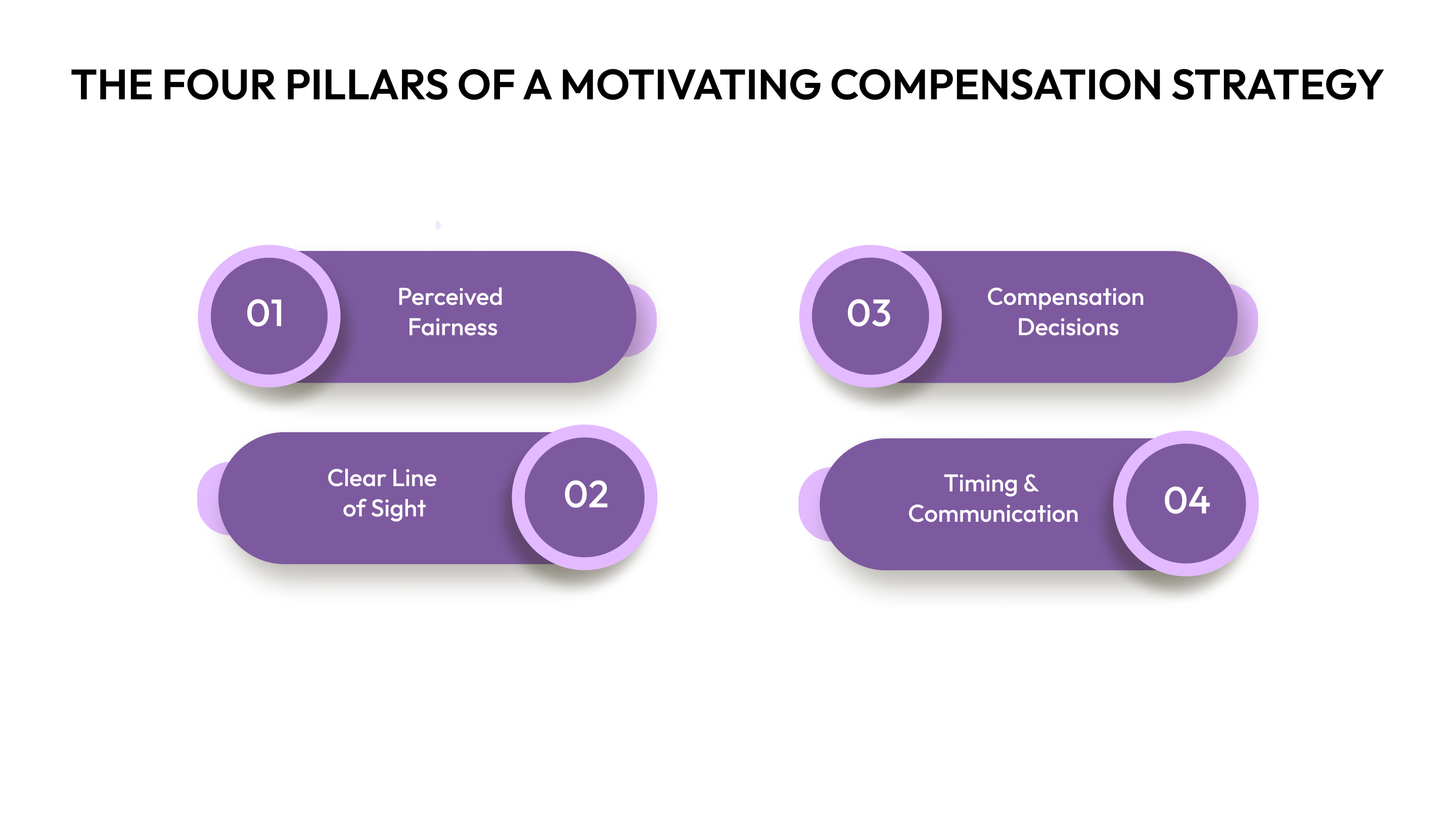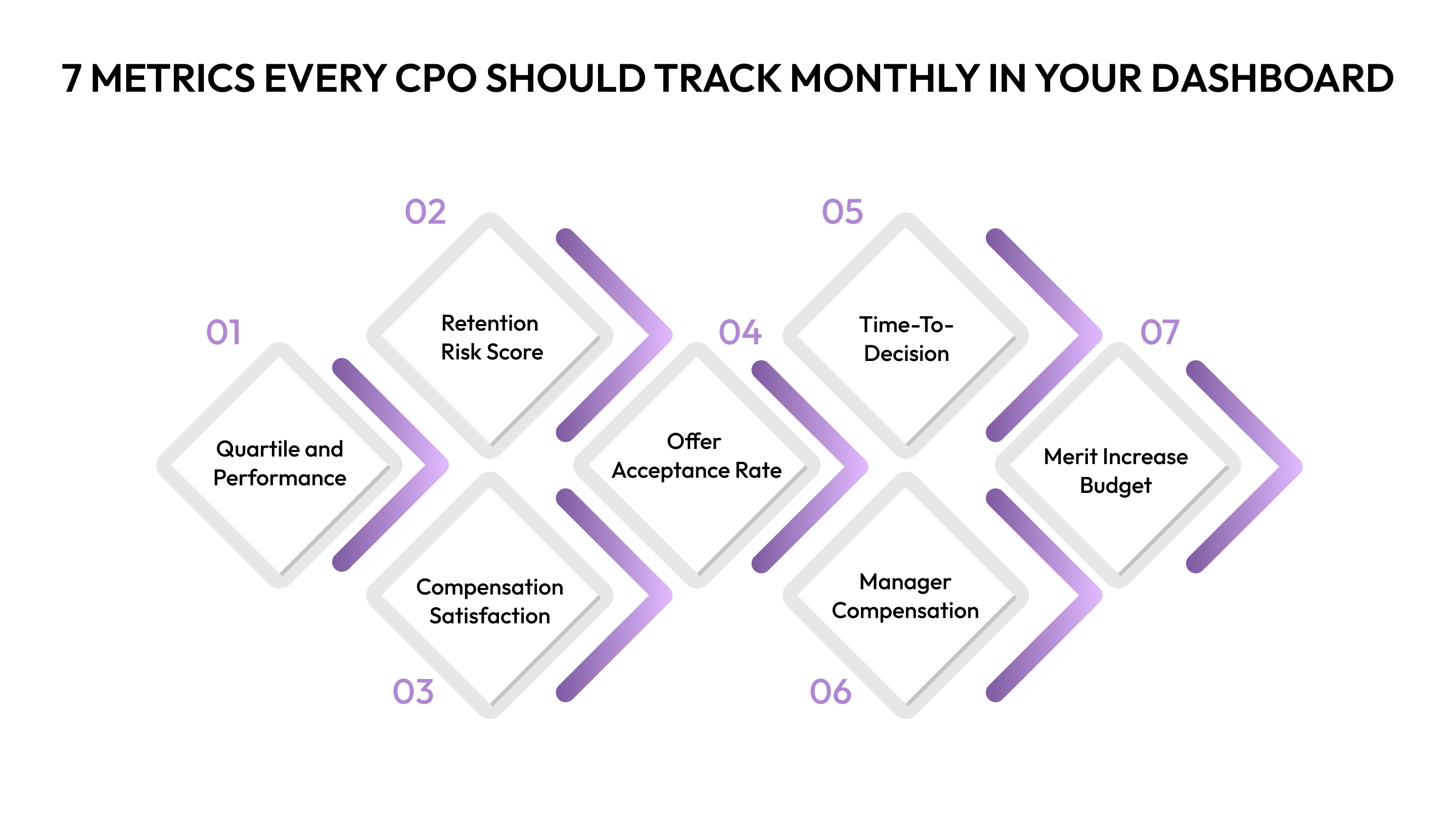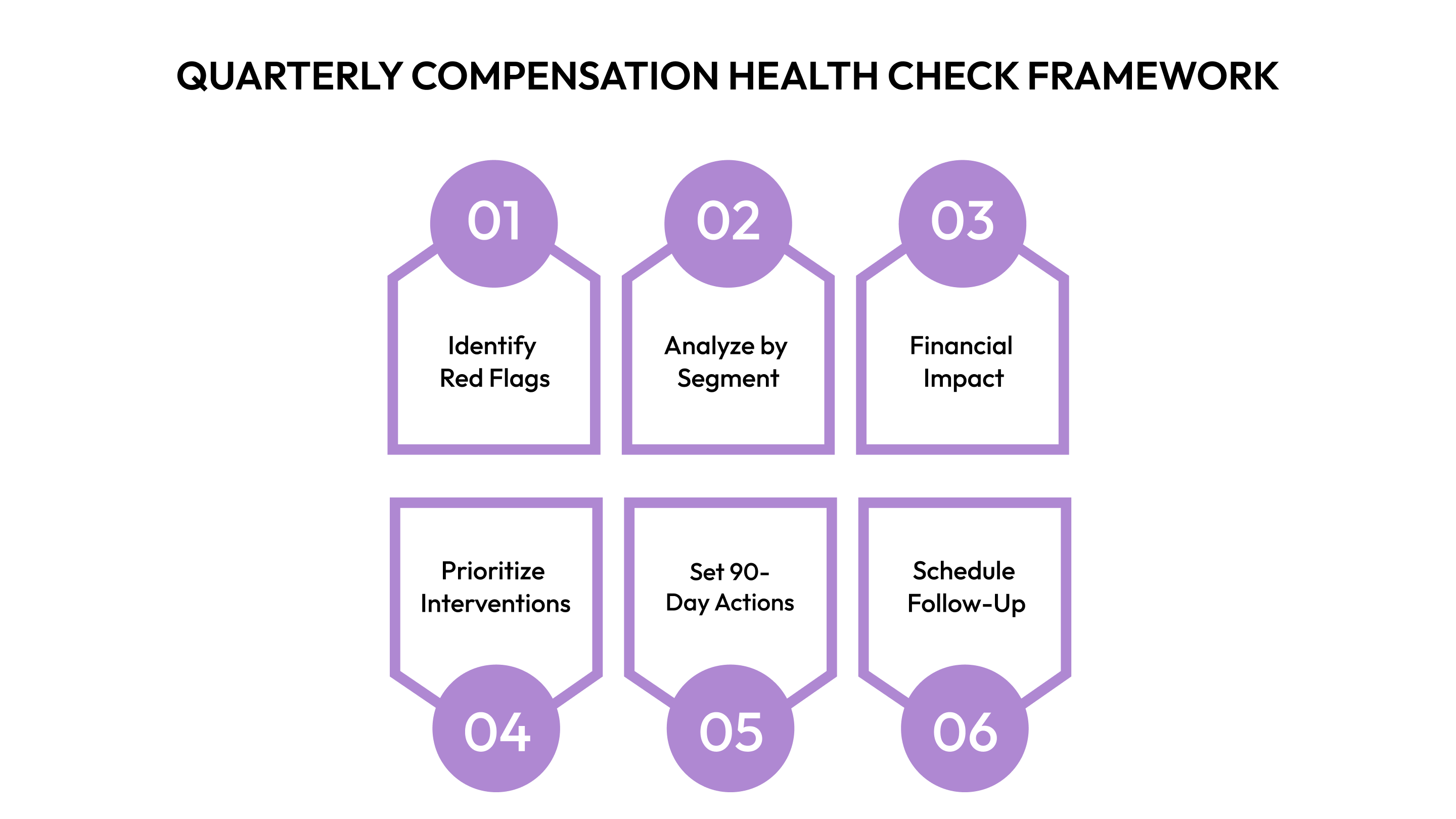What Factors Motivate Employees Through Compensation
Explore what factors, whether pay and benefits, will motivate employees, and how compensation drives job satisfaction and performance.

Your top engineer just received a 15% raise, yet they're still considering other job offers. Why? It’s a common issue. Despite rising compensation budgets, voluntary quit rates in professional services stayed at 2.2% monthly till August 2025.
The problem isn’t always the pay; it’s the perception of fairness, lack of clear communication, and inefficient systems that demotivate even well-paid employees. Hence, for scaling companies, traditional compensation methods such as annual reviews and spreadsheets no longer work.
This guide reveals how to create compensation systems that drive motivation through transparency, efficiency, and alignment with your company’s growth.
At a Glance
- Traditional compensation models fail at scale because employees compare themselves to peers, not market rates. One unexplained pay gap can destroy trust faster than any raise.
- Motivation isn’t about paying more; it’s about perceived fairness. Your top engineer may leave despite a 15% raise if they find a peer earning more for the same work.
- Compensation motivation relies on four pillars: fairness (transparent bands), line of sight (clear pay-to-performance link), manager autonomy (fast decisions), and strategic timing (quarterly check-ins).
- Leading indicators, like compensation satisfaction scores and retention risk, predict turnover 3-6 months early. Manual spreadsheets can create inequities due to errors and outdated data.
- Proactive compensation adjustments deliver a 5:1 ROI over reactive retention bonuses. Solutions like CandorIQ automate tracking and decision-making, turning reactive scrambling into a strategic advantage.
Why Traditional Compensation Motivation Models Break Down at Scale

The compensation strategy that worked for 50 employees won’t scale to 500. What thrived with founder-approved salary decisions falls apart as teams grow, budgets tighten, and operations get complex.
Here’s why the traditional compensation playbook fails:
- The hygiene factor kicks in: Psychologist Frederick Herzberg found that certain factors, like salary, prevent dissatisfaction but don't create motivation. Once employees hit financial stability, additional raises stop motivating and simply prevent dissatisfaction. Your $15,000 increase buys temporary relief, not long-term engagement.
- Internal comparison replaces market comparison: Employees don't benchmark against Glassdoor; they compare themselves to coworkers. When one of your valued employees discovers a peer makes 12% more for identical work, your entire compensation budget becomes a demotivator.
- Opacity breeds resentment at scale: The "trust me" approach works with 15 people. At 150, without clear bands and criteria, every compensation decision feels arbitrary.
- Manager quality varies wildly: You now have 20 managers having compensation conversations, each with different skills and messaging. Inconsistency kills motivation faster than low pay.
- Spreadsheets create inequity by accident. Manual tracking means errors, outdated data, and decisions made without full context. Here, fairness becomes impossible. Modern compensation management software addresses these operational challenges by centralizing data and ensuring consistency across the organization.
Understanding why traditional compensation models fail is only part of the equation. The real challenge is figuring out what works.
.png)
The Four Pillars of a Motivating Compensation Strategy

After analyzing compensation strategies in hundreds of scaling companies, four key pillars consistently separate those that motivate employees with compensation from those that just maintain the status quo. These are actionable frameworks designed to tackle the specific challenges faced by companies with 50-5,000 employees and distributed teams.
Pillar 1: Perceived Fairness (The Foundation)
Internal equity always trumps external competitiveness. Your engineer doesn’t care if she’s paid at the 65th percentile of the market; she cares if her teammate with similar experience makes $15,000 more. Fairness isn’t about equal pay; it’s about being able to explain it.
Start by building transparent compensation bands with clear criteria for each level, experience, impact, and technical complexity. When these bands are clear, conversations about pay discrepancies shift from frustration to understanding: “Here’s where you are, and here’s what it takes to advance.”
Actionable Framework: The 3-Question Fairness Audit
- Can you explain every compensation difference between similar roles without referring to “negotiation skills” or “we had a budget then”?
- If you published your compensation bands internally, how many conversations would reveal unexplainable inequities?
- Are new hires paid more than tenured employees in the same role? If yes, you have compression issues.
Establishing these bands requires thorough salary benchmarking to ensure your ranges reflect both market realities and internal equity.
Pillar 2: Clear Line of Sight (The Connection)
Employees need to see the direct link between their work and their compensation. A vague “company performance” bonus won’t motivate anyone. But a quarterly bonus tied to the features a team just shipped? That resonates.
Equity is motivating when employees understand its real value. Skip the “you’ll be rich if we IPO” pitch, and instead show them today’s company valuation, what their options are worth, and how their work drives that value.
Actionable Framework: The Compensation Narrative Template
Equip managers to explain:
- How their total compensation was determined.
- What outcomes will trigger their next increase?
- How company performance influences their comp.
- The timeline and criteria for advancement.
This approach aligns with broader principles of customized employee reward strategies that recognize individual contributions and preferences.
Pillar 3: Autonomy in Compensation Decisions (The Process)
Centralized, opaque compensation decisions create bottlenecks. When managers need three layers of approval for a simple raise, it slows everything down and breeds resentment. Empower managers to make faster, fair decisions within clear parameters.
Actionable Framework: The 3-Tier Manager Enablement Model
- Tier 1: Managers approve raises within band and budget (no approval needed).
- Tier 2: Out-of-band raises require People Ops review (48-hour turnaround).
- Tier 3: Promotions or exceptions need executive approval (one-week max).
Pillar 4: Timing & Communication (The Execution)
Annual reviews create long gaps between recognition and motivation. Your high performers disengage months before their next raise. Instead, consider bi-annual reviews or continuous compensation adjustments for key roles.
The worst mistake? Reacting only when an employee gets an offer elsewhere. Build proactive compensation conversations into the rhythm of your team, quarterly check-ins, not just annual reviews.
Actionable Framework: The Compensation Communication Calendar
- Monthly: Review comp ratios and flag retention risks.
- Quarterly: Hold career and compensation discussions with each team member.
- Bi-annually: Formal reviews with merit increases and promotions.
- Ad-hoc: Off-cycle adjustments for market shifts, role changes, or retention risks (approved within 72 hours).
These compensation management strategies play a critical role in retaining top talent before they start exploring other opportunities.
These four pillars work in tandem. Get them all right, and your compensation strategy shifts from a retention problem to a strategic advantage. However, without proper measurement, you’re operating without a clear roadmap.
Key Metrics for Compensation Motivation Effectiveness
Most companies only notice compensation issues when employees quit. By then, you're scrambling, offering retention bonuses that only signal to the rest of your team that loyalty doesn’t pay. Proactive measurement shifts you from reactive to strategic, spotting motivation problems before they turn into turnover costs.
Leading Indicators: Early Warning Signs
Leading indicators act as a warning system, giving you 3-6 months to address motivation issues before they lead to turnover.
- Compensation satisfaction surveys: Skip generic questions like "Are you satisfied with your pay?" Instead, ask, "Do you understand how compensation decisions are made?" and "Do you feel your pay is fair compared to peers?" Scores below 60% typically predict turnover within a quarter.
- Retention risk scoring: Calculate where employees sit within their compensation bands. High performers in the bottom 25% of their band? They’re likely already looking for new opportunities. Track this monthly and flag anyone at risk of leaving.
- Manager compensation conversation quality: Track the percentage of managers holding quarterly compensation discussions. If managers aren’t having these conversations, motivation suffers, even if pay is competitive.
- Offer acceptance rates by compensation band: If you’re closing 80% of offers for mid-level roles but only 40% for senior roles, your senior bands are misaligned with the market. Track this monthly; it not only impacts hiring but signals retention risk for current employees.
While leading indicators warn you, lagging indicators show you what's already broken.
Lagging Indicators: Confirming the Problem
Lagging indicators confirm what's already happening. While useful for reports, they often arrive too late to take preventative action.
- Turnover rates by comp quartile: Ideally, bottom-quartile employees will have higher turnover (performance-based attrition), but if top-quartile employees are leaving at higher rates, you have a major retention issue. This is a red flag that requires immediate investigation into equity and competitiveness.
- Time-to-fill roles: When compensation packages are misaligned with market rates, hiring takes longer. Track time-to-fill by role and geography—patterns reveal where your compensation strategy is failing to attract talent, which in turn can predict retention issues.
- Internal mobility patterns: Healthy companies see 15-20% internal movement annually. If mobility drops below 10%, employees may feel stuck in their current roles, fearing that switching teams will hinder their compensation growth. If it exceeds 30%, employees may be hopping internally to chase raises, signaling an issue with your progression system.
- Performance rating distributions across comp bands: Higher performers should earn more. If top performers are clustered in low comp bands, your compensation is detached from merit, undermining motivation more than pay discrepancies.
Collecting metrics is pointless if you don't act on them. Here's how to turn data into decisions.

How to Build Your Compensation Motivation Dashboard
Your dashboard should speak to three key audiences: yourself (operational details), your CFO (financial impact), and your board (strategic health).
7 Metrics Every CPO Should Track Monthly in Your Dashboard

You should focus on financial efficiency and business impact. Show ROI, not just compensation spend, highlight voluntary turnover rates, offer acceptance, time-to-fill impact, and compensation philosophy alignment with financial goals.
- Compa-ratio by quartile and performance: Ensure top performers are above 1.0 and bottom performers are below 0.95.
- Retention risk score: High performers should be above the 40th percentile of their band; ideally, none should fall below.
- Compensation satisfaction survey scores: Aim for 70%+ agreement on fairness and understanding of compensation decisions.
- Offer acceptance rate: Target 75%+ acceptance across all roles and locations.
- Time-to-decision for approvals: Keep it under 72 hours for off-cycle raises and 2 weeks for promotions.
- Manager compensation conversation rate: Ensure that 90% or more of managers complete quarterly compensation discussions.
- Merit increase budget utilization: Target 95-105% utilization to avoid over- or under-spending.
Building a comprehensive dashboard from scratch can be overwhelming, but tools like CandorIQ come with pre-built dashboards that automatically track these critical metrics, allowing you to spot trends and take action faster:
However, your metrics only matter when you know what "good" looks like.
Benchmarking Effectiveness
Compare your metrics to industry standards: 10-15% voluntary turnover is healthy for tech, and <30 days time-to-fill is excellent. But don’t just benchmark against others, track your own progress. Is retention risk decreasing? Are compensation conversations improving? Focus on trends, not just static numbers.
Actionable Framework: Quarterly Compensation Health Check Template

Turn your quarterly review from a dreaded obligation into a strategic planning session with this 30-minute framework. Run this 30-minute review every quarter:
- Identify red flags: Any metrics 20%+ off target? Any sudden changes from last quarter?
- Analyze by segment: Where are the problems concentrated? (Role, level, geography, tenure)
- Calculate financial impact: What’s the cost of current trends? (Turnover, time-to-fill, compression fixes)
- Prioritize interventions: Which issues affect the most people or the highest-value employees?
- Set 90-day actions: Specific, measurable steps with owners and deadlines
- Schedule follow-up: Add review to next quarter's calendar
Measurement turns compensation from a cost center into a strategic tool. When your proactive compensation adjustments deliver 5:1 ROI compared to reactive retention offers, it changes the entire budget conversation.
Conclusion
Compensation motivation isn't about paying more; it's about paying smarter. The four pillars of perceived fairness, clear line of sight, manager autonomy, and strategic timing create systems where employees feel valued beyond their paychecks.
However, most companies lack the infrastructure to execute this at scale. Manual processes create the inequities that undermine motivation. CandorIQ helps scaling companies build compensation strategies that drive real motivation, providing real-time visibility into comp ratios, automating equity tracking, and empowering managers with consistent frameworks for compensation conversations.
Ready to transform compensation from a retention problem into a strategic advantage? Book a Demo today!
Frequently Asked Questions
1. How often should companies review and adjust employee compensation?
While annual reviews remain standard, high-growth companies are shifting to bi-annual cycles for merit increases and quarterly check-ins for compensation discussions. Off-cycle adjustments should be available for significant role changes, market shifts, or retention risks, ideally processed within 72 hours to maintain motivation.
2. What's the difference between total compensation and base salary in terms of motivation?
Base salary provides security and meets immediate needs, making it the foundation of motivation. Total compensation (including bonuses, equity, and benefits) drives long-term engagement when employees understand its value. The key is making total comp transparent—employees often undervalue benefits they don't fully understand, reducing their motivational impact.
3. How do you motivate employees who are already at the top of their pay band?
When employees max out their current band, focus on non-monetary recognition, expanded responsibilities, special projects, or lateral moves that offer growth. If they're consistently exceeding expectations, it may signal they've outgrown their role and deserve promotion to a higher band rather than staying capped.


